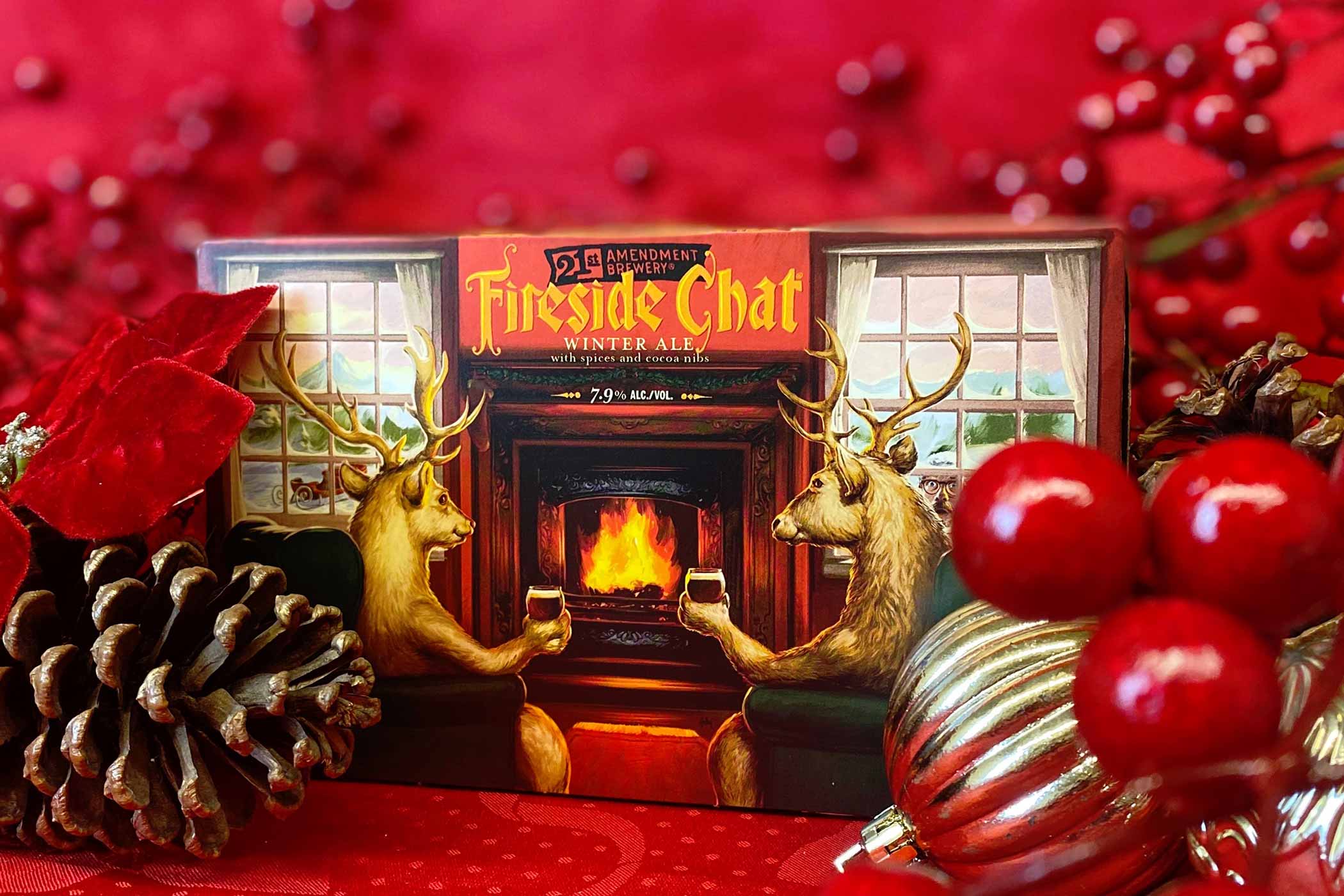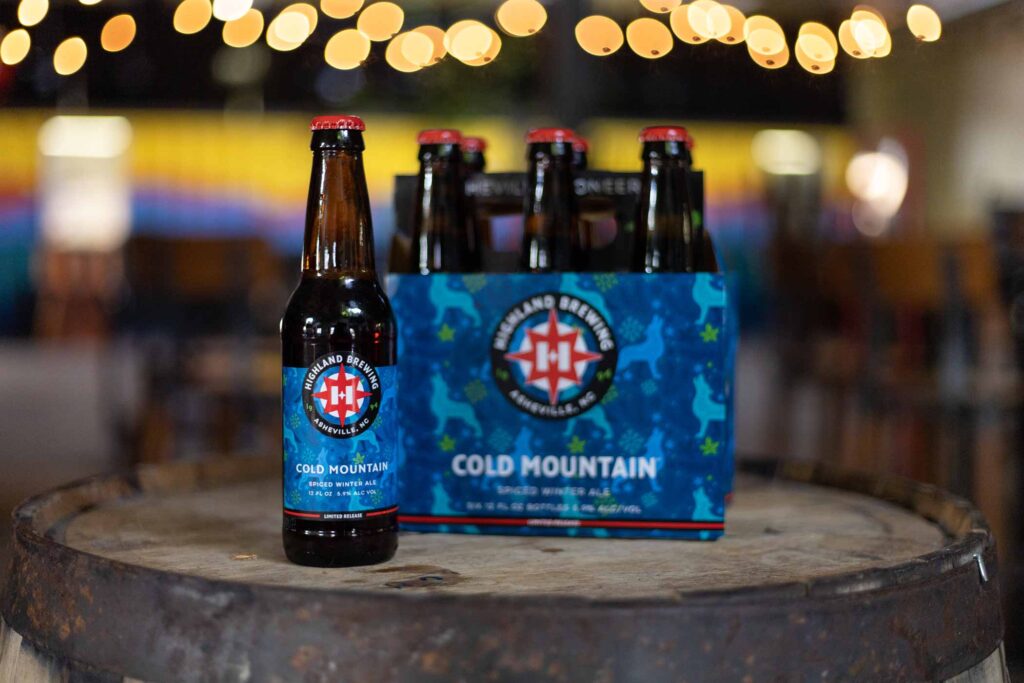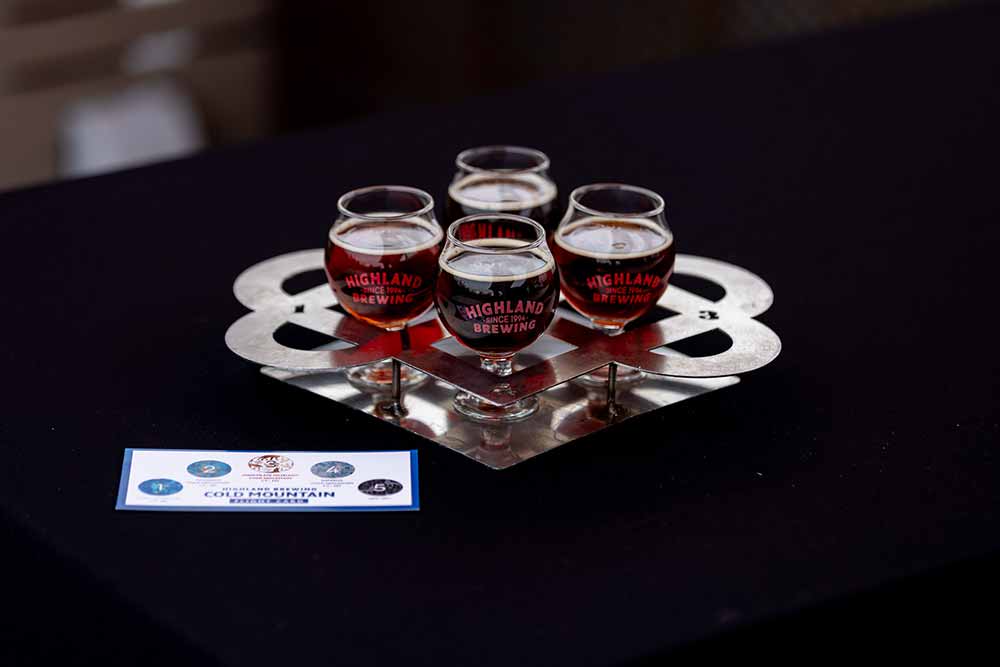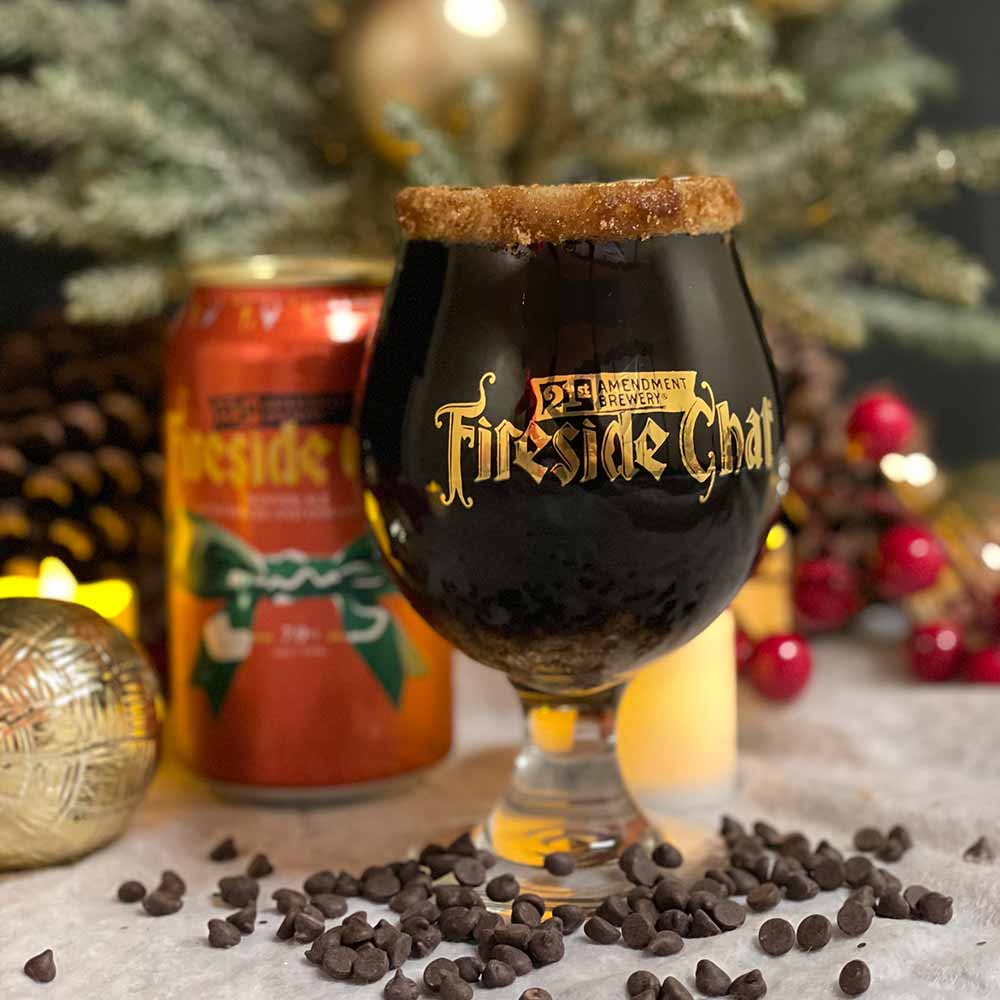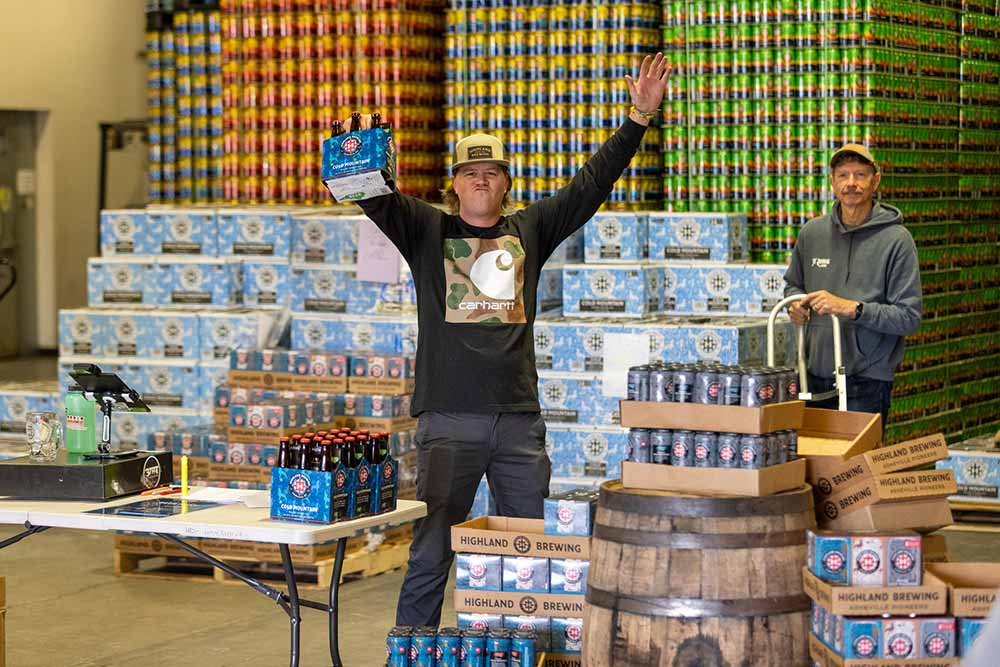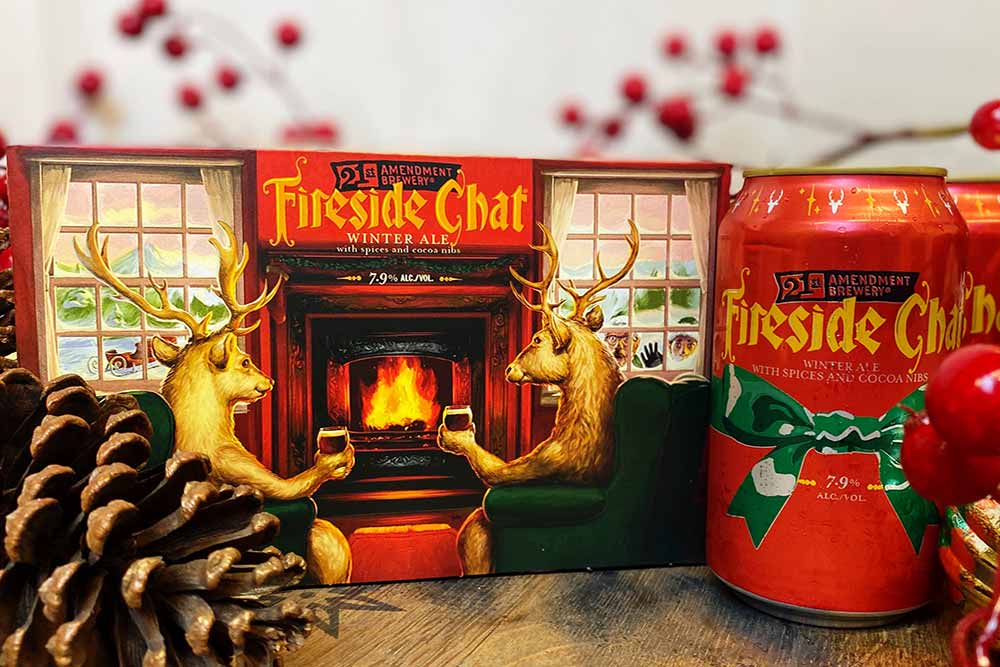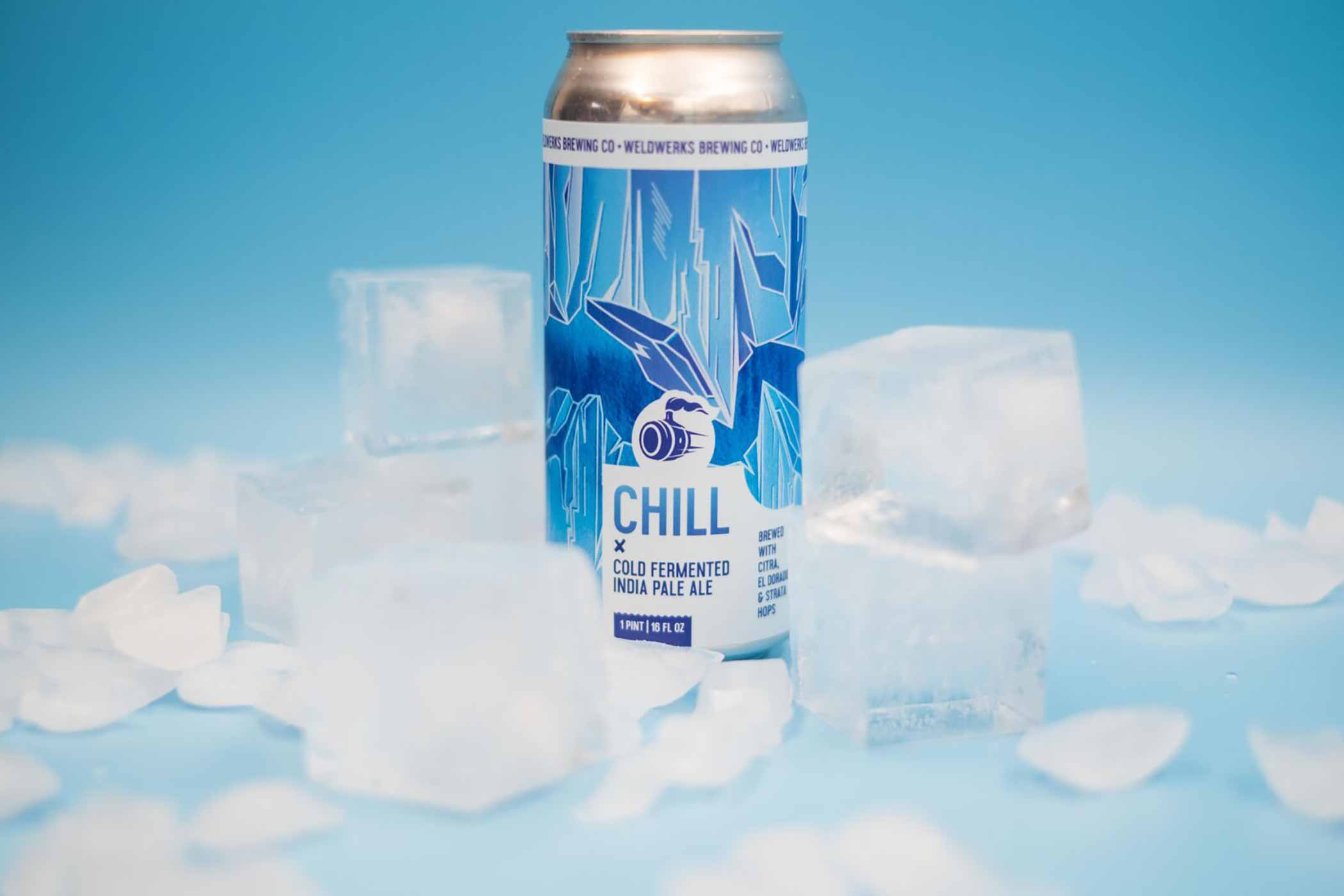Shop
What Is a Winter Warmer?
Pull up a chair by the fire.
More Stories Like This!
A couple of reindeer sit in plush forest green chairs before a roaring fire. Outside, snow-capped mountains abound while a red sleigh sits unused. Each smiling beast holds a goblet brimming with a gorgeous amber-hued liquid. They’re drinking a winter warmer or ale called Fireside Chat from 21st Amendment Brewery, enjoying one of the season’s best pleasures.
“I love this style,” exclaims 21st Amendment Brewmaster and Co-Founder Shaun O’Sullivan as he describes the scene set on the beer’s six-pack. “Honestly, it’s something near and dear to my heart.”
First brewed in England, the winter warmer originally started out of necessity. “Historically, brewers were constrained by seasonality and temperature, so higher ABV, maltier beers were stored longer. That’s why these beers were brought out of the cellar as the weather started to turn cold,” says Megan Rayfield, sensory scientist at Highland Brewing, which has been making a fan-favorite winter beer called Cold Mountain for the last twenty-seven years.
In some ways, winter warmers and ales capture intangibles like no other beer style can: season, holiday, celebration, and nostalgia.
Emphasis on the Winter and the Warmer
Traditional English beers, winter warmers don’t have a rigid definition (you won’t find any guidelines from the Beer Judge Certification Program, for example). But there are some loose characteristics.
“It’s vaguely defined,” says Fal Allen, brewmaster at Anderson Valley Brewing Company (AVBC), whose winter warmer Winter Solstice has captured the style since the early ‘90s. “The beers are usually made in the late summer or early fall for consumption throughout the colder days. They’re usually a little rounder and sweeter, sometimes spiced. … They have higher alcohol content to warm you during those cold months.”
Akin to a British strong ale with winter warmers, “I’m thinking rich and malty, nice deep reddish brown color,” says Rayfield, who believes this seasonal shift is critical for a winter warmer.
“I go to kicking off the holidays,” she says. “We’ve trained ourselves to transition into colder months with richer soups, stews, and warming things; this beer style fits right in.”
Kind of like putting your Christmas lights up after Thanksgiving or buying that first holiday gift, when you see winter warmers start to hit shelves, they signify the start of celebrations to come.
Is There a Difference Between Winter Warmer and Winter Ale?
Not really. Kind of. Maybe.
The answer varies, but most brewers agree that they’re probably interchangeable or at least “interwoven,” according to O’Sullivan, whose Fireside Chat (considered a winter ale on Untappd) has become an iconic version of the style.
For Rayfield, she says the addition of spices set a winter warmer and winter ale apart. “In my brain, winter warmer is more traditional and sticks to four main beer ingredients—water, malt, hops, and yeast—versus winter or holiday ale [and] invokes those flavors in a forward way—adding spices or flavorings to the beer.”
With Cold Mountain (originally called Holiday Ale), listed as a winter ale on Untappd, Highland Brewing adds a blend of natural flavors to capture what Rayfield calls a “spice-warming profile.”
Similarly, at 21st Amendment, O’Sullivan recounts wanting to brew his own winter warmer after trying Anchor’s referential Christmas Ale. “Anchor has always been that North Star for me,” he says. For Fireside Chat (originally called Holiday Spiced Ale), O’Sullivan went to a local grocery store and stared at their wall of spices and herbs. “I just sat there, took it in … and smelled the spices … until I figured out what I wanted to add,” he laughs.
Today, O’Sullivan won’t divulge all the secret spices he adds to Fireside Chat, but he did share that you’ll find Ghana TCHO cocoa nibs and white pepper. “It actually creates an umami flavor, especially when coupled with the cocoa nibs,” he says.
And while Winter Solstice does include some secret spices, Allen emphasizes that they don’t want that beer to be considered a spiced ale. “We prefer people think of it as a winter warmer,” he says. “So we went at the spices lightly to bring about nuanced flavors underneath the maltiness and carameliness of the beer.”
You can see how the lines between the two styles quickly get as foggy as your ski goggles on a cold day.
Allen points out that “the warmer part implies it is going to be higher alcohol,” so you can usually expect a stronger ABV with winter warmers.
He continues, “In my opinion, if you’re going to call it a winter warmer, it should have some higher alcohol—above 5.5% if you’re going by traditional British standards—but probably in the 6-7% ABV range or maybe even up to eight.”
Getting that higher ABV requires a good deal of malt, making a fuller, more round-bodied beer, which, as Allen points out, is “what people look for when they go out to have a beer when it’s cold.”
An Assault of Malt…
Listening to O’Sullivan’s list off all the different malts in Fireside Chat felt like walking through a blizzard. “There’s a lot of malts in there,” he laughs. “It’s fairly complex.”
There are some light crystal and dark crystal malts. There is also Belgian abbey malt and Munich malt. And some chocolate and other darker malts, too.
The malts are the backbone of these beers, providing color, a ton of fermentable sugars for fermentation, and those classic toffee, chocolate, and caramel notes.
“It’s kind of the equivalent of a rich stew that you’d make this time of year,” says O’Sullivan. You throw a ton of ingredients into a pot, let them simmer, and end up with a delicious, hearty meal.
Similarly, at Cold Mountain, Rayfield starts with a rich brown ale base, a combination of two-row base malt, Pilsen and Vienna malt, and layers of caramel (40 and 60) and chocolate malts. She also adds wheat and flaked oats to “bolster mouthfeel and body and have it be really nice and rich,” she says.
Winter Solstice follows in those footsteps with a malt bill of pale two-row, 40L and 80 crystal, and Munich malt, along with oat flakes.
O’Sullivan actually thinks the focus on malt is a boon to winter warmers and ales. “With the ubiquity of IPAs, it’s nice to have the balance [with a beer] where malts are amazing,” he says. “We wouldn’t have beer without malts, so while I certainly love IPAs, it’s nice to step out of that ginormous part of our craft beer world and enjoy something a bit different.”
…But Only a Tiny Pop of Hops
If malt is the shining North Star of winter warmers, the hops might be a distant twinkling Vega.
“You want the malt and spices to be the star of the show,” says O’Sullivan, who adds just a touch of U.S. Golding and Columbus hops to Fireside Chat. “The hops are toned down.”
Rayfield agrees, calling the hops the “non-speaking character in the recipe,” she shares. “Hops should really just balance. We want malts to be the star of the show, but they do need something on the other side of the teeter-totter, so you’re not flying off the handle.”
In Cold Mountain, Rayfield adds Cascade and Mt. Hood hops.
Similarly, in Winter Solstice, you’ll find old-school American hops, such as Chinook and Northern Brewer, but just to balance. “Without hops, you’d end up with something too sweet,” reminds Allen. “You want some spiciness from the hops to bring out the counterbalance with the malt.”
What you don’t want?
“Those juicy, fruity flavors you’d find in some newer hops like Equanot or Mosaic,” says Allen. “It’s definitely not a hoppy beer.”
Not Hoppy, But Still Happy
Much like the popularity of Christmas ales, winter warmers create quite a stir during the holidays.
Most breweries release a winter warmer as a seasonal, which makes complete sense. We don’t want to drink a heavier, maltier, darker beer during the hot summer months.
This limited nature has created cult followings for many of these winter warmers.
The release of Cold Mountain, named after the eponymous mountain nearby (and subject of Charles Frazier’s book of the same name), has become Highland Brewing’s “party of the year,” says Rayfield.
The brewery used to just release a small batch, and once it was gone, it was gone.
“People started camping out at the brewery with lawn chairs first thing in the morning on the day of the release and sit for hours,” says Rayfield. “Folks from town, out of town, and even out of state.”
So, over the almost three decades since first brewing this beer, Highland Brewing turned the one-day release into a full-on party.
Last year, the multi-day event attracted around 6,000 people, according to Highland Brewing Marketing and Communications Manager Victoria Branch. Festivities included a fancy beer dinner, silent disco, DJ, and more.
“You were just as likely to see a cute grandma sipping Cold Mountain as a group of twenty-five-year-old disc golf bros,” says Branch. “It’s celebratory; people are pumped to be there!”
O’Sullivan says they also throw a big party at 21st Amendment, decorating the taproom and making it festive.
“People look forward to [Fireside Chat]. It’s like people looking forward to the holidays,” he says. “Anytime these beers come out, especially at that time, they give people warm, cozy feelings, like a warm sweater.”
With winter warmers, people anticipate them.
“You need to look forward to things these days,” says O’Sullivan. “A lot is going on in the world. … You crack open these beers [like Fireside Chat], and they just pair perfectly with what’s going on at the time of year; it’s absolutely amazing.”
A Few Examples of Winter Warmers and Winter Ales to Try Right Now
Fireside Chat – 21st Amendment Brewing
San Leandro, CA
Releasing in late October and running through around the end of January, Fireside Chat, which won a medal at the Great American Beer Festival in 2001, helps “bookend the year,” according to O’Sullivan.
This celebratory winter ale pours a “beautiful, dark, rich amber-mahogany color,” says O’Sullivan, who recommends drinking the beer in a goblet to accentuate the aroma.
On the nose, you’ll find light spice notes. “The goal is not to have any one spice overpower the other; you want them all to be in harmony together,” he says.
Taking a sip, you’ll first encounter layers of malt and light sweetness. “Then the spices dance on your tongue,” says O’Sullivan. “When you finally swallow and finish enjoying your sip, the beer doesn’t finish sweet. … The whole goal is to go: I’ll have another one!”
Winter Solstice – Anderson Valley Brewing Company
Boonville, CA
Released yearly as the weather turns cold (Allen says AVBC stops making this beer by November), Winter Solstice is definitely a malt-forward beer.
“When you first open a[the beer], it has aromas of bread, caramel, and maybe a light toastiness … with a little hint of spices underneath and a light bourbon note rolling around,” he says.
Flavorwise, the beer echoes its aroma. “You definitely get malt, caramel, and very bready—maybe bread pudding-like,” says Allen. “Definitely some bourbon notes, hints of vanilla or wood, and a light spiciness from the hops.”
Cold Mountain – Highland Brewing Company
Asheville, NC
Pouring a bright, dark amber, Cold Mountain has a light brown foam on top and appears “brilliantly clear,” according to Rayfield. “You see right through it.”
Aroma-wise, she wants you to notice those warming holiday spices like vanilla and cinnamon up front, which carry through the sip to a rich, malty body.
“Vanilla sweetness balances with spicy cinnamon against the backdrop of caramel malts,” she says. “Delicate hop bitterness evens things out, warming nut flavors add complexity, and a touch of fruit on the end makes it all pop.”
While you can certainly try the OG Cold Mountain, Rayfield notes they also have spinoffs. This year included an eight-pack of three different Cold Mountain varieties such as Coconut Cold Mountain (with 300 lbs of hand-toasted coconut), Chocolate Hazelnut Cold Mountain, and Imperial Cold Mountain.
Winter Welcome Ale 2023-2024 – Samuel Smith
Tadcaster, North Yorkshire, England
Allen fondly recalls the first time he tried a winter warmer—Samuel Smith’s Winter Welcome Ale.
“My recollection of that beer … it’s higher in alcohol, so has some warming; it’s caramelly; it’s got some more fruity notes from a warm fermentation.”
According to Samuel Smith, in 2023, the brewery celebrated the one-hundredth anniversary of this historic winter ale, which features a different collectible label every year.
As the brewery writes in the beer’s Untappd description, “The full body resulting from fermentation in ‘stone Yorkshire squares’ and the luxurious malt character, which will appeal to a broad range of drinkers, is balanced against whole-dried Fuggle and Golding hops with nuances and complexities that should be contemplated before an open fire.”
Jubelale – Deschutes Brewery
Bend, OR
A recommendation from O’Sullivan, Jubelale is another excellent version of a winter ale.
“It’s more in this style of holiday beers,” he says.
First brewed in October 1988, Jubelale has stood the test of time. Opening as a brewpub in June of 1988, Deschutes wanted to create a beer specifically to celebrate Christmas that same year. Fashioned as an English strong winter ale, Jubelale was actually the first beer Deschutes bottled, releasing thirty-five cases of 750mL bottles capped by hand.
According to Deschutes’ first brewer, John Harris, the brewery bought used champagne bottles, cleaned and sanitized them, and took the labels off, hand-labeling their own makeshift design.
Over thirty years later, Jubelale now features a different label each year. Often showcasing a local Pacific Northwest artist.
And the beer inside remains timeless, pouring a beautiful deep amber.
Dark and malty with notes of “chicory, earth spice, and fruit. To beer lovers, it’s like Yule fire and family,” writes Deschutes in the beer’s Untappd description.
Første Snø (Cellar Series) – Põhjala
Tallinn, Harju maakond, Estonia
A top-rated version on Untappd, the winter warmer from Põhjala is aged in cognac barrels. Part of the brewery’s “Cellar Series,” which holds down several dozen 4.0+ ratings on Untappd, Første Snø similarly captured a 4.05 rating. The Estonia-based brewery calls this a “rich and malty winter warmer.”

